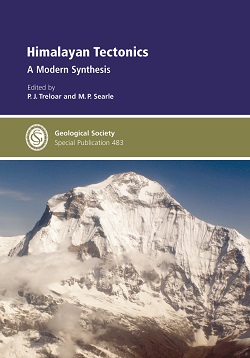Himalayan Tectonics: A Modern Synthesis
 This is a quite outstanding superb summary of present knowledge, in 21 accounts, by ~50 leading experts on the tectonics, structure, stratigraphy, metamorphism, magmatism and geophysics of the Indian-Asian collision zone which produced the highest mountains in the world. The coloured maps and cross-sections make the complex geology - produced by the initial impact with Asia of northward moving oceanic crust giving obducted (largely eroded) and subducted arcs and the later collision of the northern Indian continent under Asia - easy to follow. Initiation was ~120 Ma with the main continental collision from ~55 Ma continuing today.
This is a quite outstanding superb summary of present knowledge, in 21 accounts, by ~50 leading experts on the tectonics, structure, stratigraphy, metamorphism, magmatism and geophysics of the Indian-Asian collision zone which produced the highest mountains in the world. The coloured maps and cross-sections make the complex geology - produced by the initial impact with Asia of northward moving oceanic crust giving obducted (largely eroded) and subducted arcs and the later collision of the northern Indian continent under Asia - easy to follow. Initiation was ~120 Ma with the main continental collision from ~55 Ma continuing today.
After a most helpful introduction, the text is grouped under Timings and stratigraphy; NW Himalaya; Nepal Himalaya; Geophysics; Karakoram-Pamir-Tibet; and the Monsoon system (mountain influence). The geophysics is earthquake studies and seismically deduced thrust and back thrust packets that make a crust up to 80 km thick. The relatively simple E-W 1500 km of the main Himalayan range, with four main thrusts or detachments and a northern batholith, occurs between two complex syntaxis regions at each end. Here the range sharply bends southwards and post Miocene metamorphism continues variably overprinting the main 46 Ma Eocene to Miocene metamorphism. At the NW syntaxis the Kohistan arc separates the Indian and Asian plates and was first thrust southwards onto the Indian plate and then northwards under Asia.
Major problems, often identified, remain, such as the South Tibetan detachment with anticlockwise P-T-time metamorphism in its ductile shear zone, the opposite of the re-assuring general Himalayan Cenozoic clockwise picture in a pile of variably folded thrust and back thrust packets, many moved hundreds of km. Some packets reveal gneiss domes and metamorphic core complexes that have moved horizontally before being propelled upwards; others unexpectedly still preserve Ordovician metamorphism or 1860 Ma ages; one of the last is without Cenozoic imprint despite being <1km below the Main Mantle Thrust. Cretaceous lawsonite blueschists, eclogites, some of Eocene age with coesite and some with Oligocene-Miocene granulite facies overprinting, and earlier microdiamond-bearing rocks occur. Some Ultra-High-Pressure rocks had astonishingly high exhumation rates (45-90 mm per year) which were sometimes increased by major rivers constantly removing floods of clastic sediments thus reducing overburden pressures.
Overall this is a quite outstanding book of an extremely complicated region that is unreservedly recommended, giving a glimmer of what happened in the top levels of older orogenies, now lost forever by erosion.
Reviewed by Bernard Elgey Leake
HIMALAYAN TECTONICS: A MODERN SYNTHESIS by Peter J. Treloar & Mike P. Searle (eds), 2019. Published by The Geological Society 669pp (hbk) Special Publication 483, ISBN: 9781786204059 List Price: £ 160.00. W: https://doi.org/10.1144/SP483.2